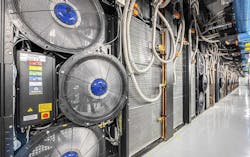Equinix Explores Using Hydrogen Fuel Cells in its Data Centers
Equinix is exploring the use of hydrogen as a green fuel source in the company’s data centers, and has created a research project in Singapore to develop a proof-of-concept, the company said today.
As one of the largest data center operators, Equinix is positioned to play a leading role in the transition to greener energy technologies to support the growth of the Internet. A key element of that transition is developing sustainable electricity sources for the generators that provide emergency power during utility outages.
Equinix will partner with the Centre for Energy Research & Technology (CERT) to launch a research project to compare the efficiency of proton-exchange membrane (PEM) fuel cells and fuel-flexible linear generator technologies. PEM fuel cells are a leading contender for hydrogen energy, while fuel-flexible linear generators enable operators to easily switch between various clean fuel options including hydrogen, biogas and various renewable liquid fuels.
These technologies “may allow data centers to reduce carbon emissions while meeting the rising demand for data, colocation and interconnection services,” Equinix said. The CERT is part of the National University of Singapore’s (NUS) College of Design and Engineering.
Focusing on Tropical Data Centers
The research collaboration between Equinix and CERT will involve a holistic assessment of these technologies for tropical data centers, considering local climatic conditions, site constraints, power demand, supply chain, fuel storage capabilities as well as local regulatory policies.
“Data centers serve as the conduit powering the digital economy, and greening their operations can drive the rise of sustainable business throughout the broader economic landscape,” said Yee May Leong, Managing Director, South Asia, Equinix. “Working with like-minded partners like the Centre for Energy Research & Technology at NUS empowers us with the combined experience and expertise to advance the growth of digital economies in line with environmental obligations, benefiting the data center industry, global economies, and the planet.”
As part of the research initiative, Equinix expects to develop proof-of-concept projects within its global network of data centers for real-world testing and incorporation into future data center designs.
“By driving innovation in Singapore, the Equinix and CERT partnership aims to accelerate disruptive technologies that can reduce the carbon footprint of global data centers, particularly in tropical locations,” the partners stated.
The Potential of Hydrogen Power
Hydrogen has always been envisioned as a potential fuel to power a clean revolution, but hydrogen fuel cells have remained elusive as a production option, lacking the economics and scale for data center production.
That began to change in July 2020, when Microsoft announced plans to end its reliance on diesel fuel by 2030, a decision with major implications for data centers around the world. Diesel generators play a central role in ensuring that mission-critical data center applications never go offline, as part of a redundant electrical infrastructure that also includes uninterruptible power supply (UPS) systems and batteries.
After several years of testing, Microsoft recently teamed with Plug Power to deploy a 3-megawatt hydrogen-powered energy system, which is large enough to replace a traditional diesel generator. That project also used PEM fuel cells, which combine hydrogen and oxygen in a chemical reaction that generates electricity, heat and water – with no combustion, no particulate matter and no carbon emissions. PEM fuel cells are commonly used in the automotive industry because, like diesel engines, they are quick to turn on and off, and can follow a load up and down.
The Singapore project is part of Equinix’s Future First strategy for greening the digital economy. Green hydrogen has been identified as a viable source of sustainable energy, but hydrogen generation on an industrial scale remains several years away from being commercially viable. In the meantime, Equinix wants to be ready to deploy at scale once fuel is available.
Building on Green Initiatives
Equinix is already part of the Clean Hydrogen Partnership, a European collaboration between seven companies – Equinix, InfraPrime, RISE, Snam, SOLIDpower, TEC4FUELS and Vertiv – to develop low-impact fuel cells combining solid-oxide fuel cells and UPS systems using lithium-ion batteries.
The digital infrastructure company has also created a Co-Innovation Facility in Ashburn, Virginia where it operates liquid-cooled servers supported by fuel cells, sodium-ion batteries and intelligent power management.
A new wrinkle in Singapore is the focus on fuel-flexible linear generators, which offer the ability to switch between fuels like hydrogen, biogas and various renewable liquid fuels, enabling the installation of infrastructure that can be easily adapted to market conditions and fuel availability in different regions.
“We are keen to work with industry partners like Equinix, which is known for its sustainability efforts and provides us access to a global network of data centers that can serve as a testbed for a more accurate assessment of operational viability,” Associate Professor Lee Poh Seng, Director, Centre for Energy Research and Technology, NUS College of Design and Engineering. “Through this partnership, we look forward to playing a driving role for green data center innovations that can be applied in Singapore and globally.”
About the Author



